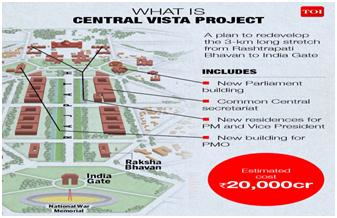

By a 2-1 majority, the Supreme Court gave the thumbs-up to the Central government’s over ?15,000 crore redevelopment plan for the historically significant Central Vista area of New Delhi where a new Parliament, Central Secretariat and union ministries’ offices are to be built.
Context
By a 2-1 majority, the Supreme Court gave the thumbs-up to the Central government’s over ?15,000 crore redevelopment plan for the historically significant Central Vista area of New Delhi where a new Parliament, Central Secretariat and union ministries’ offices are to be built.
About
The central vista project
- The project aims to renovate and redevelop 86 acres of land in Lutyens’s Delhi, in which the landmark structures of the Indian government, including Parliament House, Rashtrapati Bhavan, India Gate, North Block and South Block, etc. stand.
- The “Prime Minister’s dream project” of redeveloping the nation’s administrative heart was announced by the Ministry of Housing and Urban Affairs on September 13, 2019.
- The redevelopment project of the Central Vista -- the nation’s power corridor – envisages:
- a new triangular Parliament building
- a common central secretariat
- revamping of the three-km-long Rajpath, from Rashtrapati Bhavan to India Gate
|
Features of the new building
|
Background
- A petition was filed in the Supreme Court in April 2020, challenging the Centre’s change-of-land-use notification of March 2020 with regard to the 86 acres of land.
- The petition argued:
- The order violated the citizen’s Right to Life guaranteed under Article 21 by depriving people of open and green spaces.
- The notification violated the Master Plan of Delhi 2021.
- Subsequently, the court heard the challenge on three main grounds:
- change of land use
- violations of municipal law
- violations of environmental law
Limitations in the current buildling structure
- The Parliament building in Delhi is over 100 years old. It was originally built by the British for the Imperial Legislative Council.
- Since Parliament is a heritage building, there are severe limitations to the structural repair, alteration and modifications that can be made.
- The existing Parliament building:
- lacks several safety features such as earthquake-proofing
- lackof a standard fireproofing system
- inadequate office space
|




